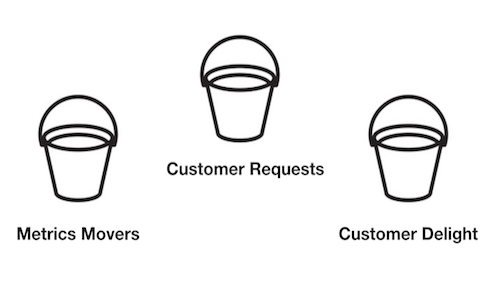Product Manager Framework: Three Feature Buckets

In the spirit of capturing some of the observations that I find myself repeating, I’m adding this one to the mix tonight. Unlike the previous two, this is really a piece of concrete advice for product managers of consumer software or consumer internet products. It’s also a more recent observation that I’ve formulated in the past few years.
This advice takes the form of a simple classification framework for the features that you are considering for a product, whether it’s a single “large scale” launch, or a series of product features that are planned out on a roadmap.
Place your feature concepts in one of three buckets:
Metrics Movers. These are features that will move your target business & product metrics significantly. In most healthy product organizations, there are specific goals and strategies behind the decision to invest in a product or feature. Engagement. Growth. Revenue. Typically, very few features are actually metrics movers. Know which ones they are ahead of time, because in the end, the judgment of whether your product or roadmap succeeded or failed will rest on the evaluation of the metrics. Customer Requests. These are features that your customers are actively requesting. There is no mystery here. Listen to your customers, and know which features they want to see the most. You don’t necessarily want to implement every suggestion, but product professionals need to listen to direct requests carefully, with humility and deep consideration. Nothing irritates customer more that to see you roll out new features that exclude the ones that they have already identified and requested actively. Customer Delight. These are features that customers haven’t necessarily asked for, but literally delight them when they see them. Typically these are features that require several ingredients: listening to customers to understand their pain points, leveraging a knowledge of technology to know what might be possible, and innovative design to come up with an unexpectedly elegant & delightful experience. Don’t get me wrong – there are some features that can fall in more than one bucket, but it’s a rare feature that actually falls in all three.
I’ve found that categorizing features into these buckets forces product teams to be intellectually honest with why they are implementing a certain feature. Is it because customers want it? Or is it because the company wants it (to move metrics)? Or is it just cool?
For large, monolithic releases of features, optimal success comes from packaging up items from each of these buckets. The customer requests ensure that your customers see that the time that they are investing in your products is rewarded by a provider who listens and delivers. Your metrics movers ensure that the business and strategy you are executing on will provide the resources to invest in future iterations. And your customer delight features highlight your ability to leverage expertise in technology & design to deliver innovative capabilities.
Conversely, if you find yourself without one of these buckets represented, it likely represents a serious hole in either your channels for customer feedback, your product execution, or your innovation capabilities. These holes will significantly impact both your short term and long term success in this area.
Most consumer internet companies don’t ship monolithic feature redesigns often – instead they release small iterations and additions frequently. (At LinkedIn, we release every week.) The logic above, however, can just as easily apply to a series of 1-2 week features executed over the course of a three month roadmap as a large monolithic release.
Take a moment and consider major product releases in the consumer space that you really respect as a product professional. I think you’ll find that these releases have all three of these buckets well represented. (iPhone 3.0 is not a bad recent example.)
Source: adamnash.blog
